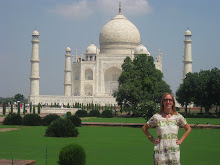William Darymple is an intrepid and perceptive British chronicler of the country previously known as the "jewel in the crown" of Britain's empire. In Delhi, he takes you down twisting alleyways to little known partridge fights and into massive throngs for Muslim pilgrimages. He peoples his narrative with quirky Sikh cab drivers and fierce (if not misguided) Mughul sultans. He peels away the layers of Delhi, a city said to encompass seven "dead" cities, each successive layer of civilization built upon the ruins of its predecessor. He brings rich context to the dizzying array of temples and landmarks that punctuate Delhi's neighborhoods.
And he does all of this with a wonderful dry wit, as when he describes navigating the city streets:
Although during my first year in Delhi I remember thinking that the traffic had seemed both anarchic and alarming, by my second visit I had come to realize that it was in fact governed by very strict rules. Right of way belongs to the driver of the largest vehicle (15).The book begins with two charming hand-drawn maps, one of Delhi and one interpretation of Old Delhi. These are not maps to travel by; rather, they are lovely frames for the narrative. To look back at the highlighted locations after having read the book is like looking through a photo album. "Oh, remember when Dr. Jaffrey and William visited the temple of the great mystic Nizam-ud-Din?" you'll ask yourself. "Or how about the Mumtaz Mahal: the palace of Jahanara Begum, Shah Jehan's favored daughter who held illicit orgies on its premises and was boiled alive by her father when she was caught doing so?"
To write the book, William Darymple stayed in the city for one year and took his new wife, Olivia Fraser, with him. She is a minor character in the narrative, only appearing when she is propositioned by the landlord or chided by the landlady for not being demanding enough of her household servants and allowing them to do an insufficient job dusting. Her larger presence is felt in her line drawings (such as the introductory maps) that appear with little comment throughout the text but lend to the impressionistic tone of the book.
Temporally, the book slips in and out of present day into stories of prime ministers, English colonials, Mughal sultans, Persian invaders and ancient Hindu civilizations. For a region with such a dizzying and lengthy history, the structure of the book does little to elucidate this complexity. But no matter; one gets the sense that any simplification would be a disservice, that the essence of Delhi is the intricate weave of cultures colliding and merging through the millenia, and that finally, one's understanding will not be whole, but rather fragmented, momentary, focused, like Olivia Fraser's drawings which are studies of details rather than whole scenes: a man standing in an arched doorway, a shoe-shine boy sitting cross legged on the sidewalk, or the facade of a building.
Darymple begins his book by saying Delhi's history is not confined to architectural ruins:
But where Delhi was unique was that, scattered all around the city, there were human ruins too. Somehow different areas of Delhi seemed to have preserved in tact different centuries, even different millenia... Minds set in different ages walked the same pavements, drank the same water, returned to the same dust... In Delhi I knew I had found a theme for a book: a portrait of a city disjointed in time, a city whose different ages lay suspended side by side as in aspic... (9).So it makes sense that Darymple does not unwind Delhi's history in orderly fashion. All of its strands tangle together to form a new weave. Perhaps it's not as important to know which civilization came first and who followed whom in the march of history. There is no one convenient and clean timeline. There are timelines which intersect and cross over and still walk around and talk to each other today.
Now I can look at my guidebooks and know that where a footnote exists about an emperor or a landmark, there is a fascinating and lively saga underneath. Darymple's City of Djinns has enriched my understanding of the people and the architecture I will see. I wouldn't have wanted to experience Delhi without it.


No comments:
Post a Comment